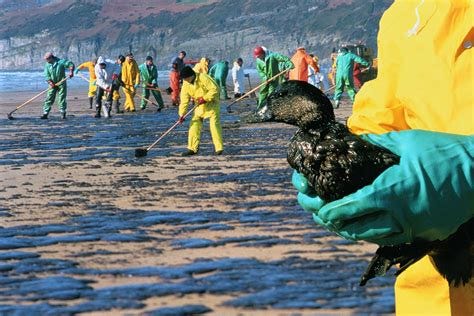Plastic bags and oil spills: solving one problem with another
Turns out that plastic bags are good at absorbing oil spills
The problem with plastic bags
From the time that people started making bags out of plastic, they proved to be a problem. Back in 1959, the city of New York started requiring that a warning label—DANGER: KEEP AWAY FROM CHILDREN—accompany any and all plastic bags used by cleaning establishments.1 Parents and guardians had too often left a plastic bag in a room with a small child, only to return to find the child inadvertently suffocated while he or she played with the bag.
It may seem that the drive to ban plastic bags by municipalities and regional governments is a fairly recent phenomenon, but as far back as 1988, cities and counties have tried to move stores and shoppers away from plastic for packing up and carting around groceries and other bought goods2. Reasons cited were to eliminate waste filling up landfill or to reduce pollution when the bags were burned in incinerators.
Presently, we’ve got tons and tons of plastic, and tons and tons of plastic waste. Plastic is the most prevalent waste found in our oceans and Great Lakes. When plastic is exposed to the elements, it breaks up into smaller and smaller bits, until the pieces are less than a quarter inch across or smaller. These teeny bits of plastic are called microplastics. Microplastics have been found in lakes, rivers, and estuaries. They have been found in food, with obvious health ramifications. Microplastics have so washed over the world that they have been found near the summit of Mount Everest.
Environmentally, the best thing to do is to stop making plastic. That’s not going to happen. One of the things to mitigate plastic pollution is to do something useful with plastic waste. keep that in mind while we look at the problems of oil spills in our oceans.
Oil spills
According to the National Research Council of the National Academy of Sciences, about 210 million gallons of oil wind up in the oceans each year.3 Almost half of that, 46 percent, comes from natural seepage from oil escaping from the ocean floor.
According to NOAA, only a small amount of the oil that winds up in the ocean is from tanker spills. Most of it, 85 percent of it, is the oil that drips from cars and trucks onto roads and then gets washed by storms downstream into the ocean. Spills from small boats and the dumping of fuel by airline pilots also contributes to the amount of oil in the oceans.4
That is the source of most of the oil in the oceans, but it is the oil spills—the shipwrecked tankers, broken oil rigs, and the broken pipelines—that cause the acute damage. The oil that they release, when it makes it close to shore, can coat ducks and shorebirds, who lose the ability to regulate their body heat when they are coated with oil. When they groom and preen, they swallow oil, which can poison and kill them.

Oil also poisons fish, crayfish, mammals, and just about everything else that swims, crawls, or breathes in intertidal areas. After the Exxon Valdez disaster in 1989, it took more than three decades for fisheries in the area to recover.
As far as the environment is concerned, the best thing we can do with oil is stop using it. Besides being a source of greenhouse gasses, it can really mess things up when it spills. But that’s not going to happen anytime soon.
The fix
We can use one problem to solve another problem. Those plastic bags can mitigate the damage from oil spills. Scientists got hold plastic bags that were collected in a neighborhood of Rio de Janeiro. They then imitated the process of what nature does to plastic bags, grinding them up into microplastics. They then put the microplastics into porous bags that would let oil and water in but not let the microplastics out.
They created an oil slick off the coast of Brazil and used their manufactured microplastics to soak it all up. They plopped the bags in the oil slick, let them soak up the oil, retrieved them and drained the oil. The scientists found that the microplastics they created were naturally resistant to soaking up water but they quite readily soaked up the oil, just what you would want in this case. The scientists published their findings in Polymer Engineering and Science in July.
The next thing is figuring out what to do with the mixture of microplastic and oil. Can the oil, once separated from the plastic be used? Or do they find a big place to dump the big mess? That could present a whole new set of problems.
For more environmental news follow me on Twitter @EcoScripsit.
Murphy, Mildred (1959, Jun 06). City moves to label plastic bags a peril: CITY ACTS TO CURB PLASTIC BAG TOLL. New York Times (1923-) Retrieved from https://www.proquest.com/historical-newspapers/city-moves-label-plastic-bags-peril/docview/114898498/se-2?accountid=8064
Special to the New,York Times. (1988, Mar 30). Suffolk votes A bill to ban plastic bags. New York Times Retrieved from https://www.proquest.com/newspapers/suffolk-votes-bill-ban-plastic-bags/docview/426764024/se-2?accountid=8064
"Oil spills." Environmental Encyclopedia, edited by Deirdre S. Blanchfield, Gale, 2011. Gale In Context: Science, link.gale.com/apps/doc/CV2644150991/SCIC?u=sddp_main&sid=bookmark-SCIC&xid=750cd6e7. Accessed 27 Nov. 2021.
ibid




